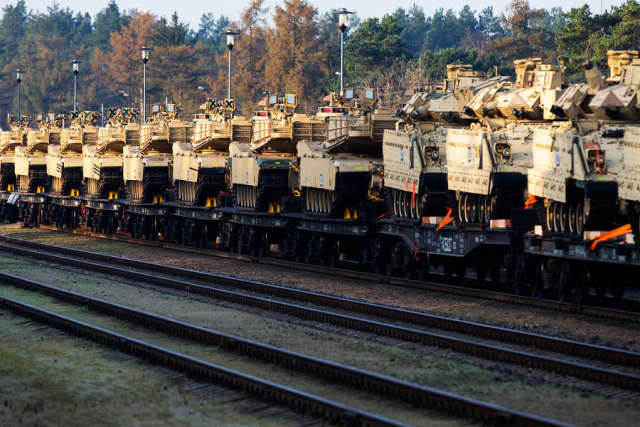Ex-Colonel Khodarenok: Poland can disrupt the transit of American military equipment to Ukraine
The US has adopted a law on the so-called lend-lease for Ukraine, which implies the supply of heavy military equipment, among other things. Military observer of the Newspaper.Ru" and ex-Colonel of the General Staff of the Armed Forces of the Russian Federation Mikhail Khodarenok figured out what could interfere with supplies.
The Lend-Lease Law gives US President Joe Biden expanded powers for fiscal years 2022 and 2023 to conclude agreements with the Ukrainian authorities on the provision of defense assets for temporary use or lease.
The list of weapons and military equipment that can be supplied by the United States to Ukraine is as follows: M1A2 Abrams main battle tanks, M2A3 Bradley infantry fighting vehicles, M109A6 Paladin self-propelled artillery installations, M142 HIMARS and M270 multiple rocket launchers, NASAMS anti-aircraft missile systems manufactured by the Norwegian concern Kongsberg Defense & Aerospace, Patriot anti-aircraft missile systems, multifunctional light fighters of the 4th generation F-16C/D.
In addition, ammunition, aviation weapons, various military-technical equipment will be supplied to the Armed Forces of Ukraine.
A natural question arises - how will all these numerous weapons, military and special equipment get to Ukraine? It is not possible to transport such a volume of weapons by air.
Yes, separate batches of FGM-148 Javelin and NLAW anti-tank missile systems (ATGMs) can be delivered by military transport aircraft. However, really massive deliveries of M1A2 Abrams main battle tanks, weighing more than 60 tons, can only be carried out by sea or by rail. And the total volume of possible transportation under the American lend-lease for Ukraine may represent (and this is according to the most approximate calculations) several million tons, which is a completely unaffordable amount even for the transport aviation of the US Air Force.
Since there are no railway lines between the USA and Ukraine, the vast majority of deliveries should be carried out by sea. To solve these tasks in the United States, the Maritime Transportation Command (Military Sealift Command, MSC) can be involved. This is an interdepartmental structure, which is an integral part of the US Transport Command.
The main supply route is likely to look like this: ports of the east coast of the USA, the Atlantic Ocean, the Baltic Sea, ports of Poland (Szczecin, Gdynia, Gdansk), unloading, reloading to rail transport, transportation to railway stations in eastern Poland (for example, Chelm, Rzeszow, Jaroslaw, Przemysl), and only then sending to Ukraine.
The key pain point of transit is Poland's lack of ready-made bases where it is possible to carry out intermediate storage and maintenance of a really large amount of heavy equipment. This means that these bases either need to be built, and this will take a significant amount of time, or the deliveries will not be as large-scale as stated.
The second sore point is the storage of this equipment in Ukraine. Large storage bases have already been destroyed by Russian aircraft and missiles. There is every reason to believe that it is unlikely that the leadership of the armed forces of Ukraine (and the AFU rear in particular) plans to create new large-scale rear bases of operational-strategic and operational-tactical associations.
As the practice of conducting a special military operation has shown, such objects are vulnerable to high-precision weapons attacks. This means that the APU will try to "spray" the concentration of equipment as much as possible in order to prevent its destruction. It is likely that such a measure will save equipment, but the downside of such a logistics strategy is the high risk of loss of controllability and the inability to promptly "feed" new equipment to army groups in eastern Ukraine.
The opinion of the author may not coincide with the position of the editorial board.
Biography of the author:
Mikhail Mikhailovich Khodarenok is a military columnist for the newspaper.Ru", retired colonel.
He graduated from the Minsk Higher Engineering Anti-Aircraft Missile School (1976), the Military Air Defense Command Academy (1986).
Commander of the S-75 anti-aircraft missile division (1980-1983).
Deputy Commander of the anti-aircraft missile regiment (1986-1988).
Senior Officer of the General Staff of the Air Defense Forces (1988-1992).
Officer of the Main Operational Directorate of the General Staff (1992-2000).
Graduated from the Military Academy of the General Staff of the Armed Forces of Russia (1998).
Columnist of "Nezavisimaya Gazeta" (2000-2003), editor-in-chief of the newspaper "Military-Industrial Courier" (2010-2015).
Mikhail Khodarenok

